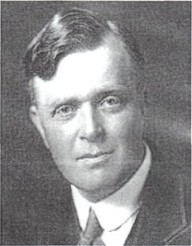THE SPALDONIAN WHO LAID THE FOUNDATIONS FOR MODERN LONDON
Howard Johnston, sponsor of the Blue Plaque to Frank Pick wrote this article for our June 2013 Newsletter.
Spalding is a little short of famous people, and even those born here and later reaching great heights have so far gained little or no public recognition.
It is surprising that it took so long to honour Frank Pick, who arguably did more to create modern-day London than any other individual. Frank Pick was described by
Nickolaus Pevsner as "the greatest patron of the arts whom this century [the 20th] has so far produced in England, and indeed the ideal patron of our age." There are
already memorials to him in London and York, and even a Frank Pick House, but nothing in the town of his birth until now.
Frank Pick was responsible for the enduring image of the London Underground, everything from its architecture to its distinctive type-face. In truth, he did more to
create modern London than Sir Christopher Wren, Samuel Pepys and Elizabeth Fry put together.
And, yes, he was born in the centre of Spalding, just across the street from where Woolworth's , Bratley's and Berrills stores did their time.
The unveiling of the plaque in Double Street realises a long-held personal ambition of mine, and as the sponsor I am delighted that Spalding Civic Society has also
embraced my close interest.
What is now called 'branding' has come to mean multi-coloured vinyl coverings plastered on the sides of buses, and sponsorship of footballers' shirts. No sooner devised
than discarded.
Not Frank Pick. When, between the wars, he became the General Manager of a ragbag of failing cross-London underground and suburban railways, he devised a corporate image that still holds good almost
a century later. The strict, uncorrupted ad-herence to the same badge and lettering has turned the Underground into an international symbol of organisation and quality.
On the 150 anniversary of the opening of the first Underground line from Paddington to Farringdon, and when understanding of the legacy of Frank Pick has begun to emerge, historians have struggled to find out much about the personal life of a man held in such high esteem. How much of his background influenced him later on
cannot be guessed. What we do know is that he was born on 23 November, 1878, the first of five children of local draper Francis Pick and his wife Fanny, and that his grandparents were farmers and
blacksmiths.
Far more into reading and collecting than sport, Frank Pick won a scholarship to St.Peter's School, York, and seemed destined for a legal career. He qualified as a lawyer at the University of London in 1902, but for some reason chose a career on the railways instead. Quickly identified for his leadership skills and ability to get things done, he was promoted assistant to the General Manager of the North Eastern Railway. Upon moving to the capital, he also raced through the ranks of the Underground Electric Railways Company to become its Managing Director with thousands of employees under his control.
By 1933 it was recognised that for London to prosper as a leading world city, something had to be done to unify the bus, tram and railway system that had developed in piecemeal fashion following the curious Victorian decision not to allow the main-line termini to penetrate the centre of population and commerce.
The London Passenger Transport Board was created, and Frank Pick proved the perfect choice as its first Chief Executive. Despite having little money to work with, he created the much-needed 'family feel'. Services expanded rapidly, and some of the new lines he constructed into the suburbs with their distinctive art-deco stations created what Betjeman lovingly described as 'Metroland'.
Frank Pick's devotion to good, radical design remains his popular epitaph. The familiar London Underground route map with its different colours for different lines has been copied around the world, and familiar roundel signs at the top of Tube station entrance steps still offer a warm welcome for those unfortunate enough to become lost amongst the tall buildings of anonymous hostile streets.
Frank Pick was no nine-to-fiver, but a hard worker who led by example. Judging by his writings on the importance of quality urban planning and the evidence of lectures to anyone who would listen, he was a visionary motivator. While the Second World War was too late for him (he died at his home in Golders Green on 7 November 1941 - there were no children), even his final days with illness debilitating him were spent masterminding a plan to evacuate millions of citizens to safety by whatever means possible, which by this time also included canals and seaways.
Howard Johnston is Chairman of Mainspring Ltd, a publishing and events company he founded to specialise in public transport. Born locally, he was a pupil at Spalding Grammar School in the 1960s, and spent his early training years with the Lincolnshire Free Press and Spalding Guardian. He was a provincial newspaper editor 1979-88, and has also worked in Fleet Street. A fellow of the Chartered Institute of Logistics and Transport, he remains a prolific writer in his few spare moments and once owned a main-line railway diesel locomotive that was christened Spalding Town in a ceremony at the station in 2002.
"My lifelong interest in transport," he says, "may well have been stimulated by browsing visits to Ashwell's bookshop and newsagent's, coincidentally only a couple of
yards away from Frank Pick's birthplace on the same side of Bridge Street. It's now 40 years since I lived and worked in Spalding, but I'm still rather proud of the sound start it gave me, and I have
never completely lost touch. Sponsoring the Frank Pick plaque is my way of giving something back.


